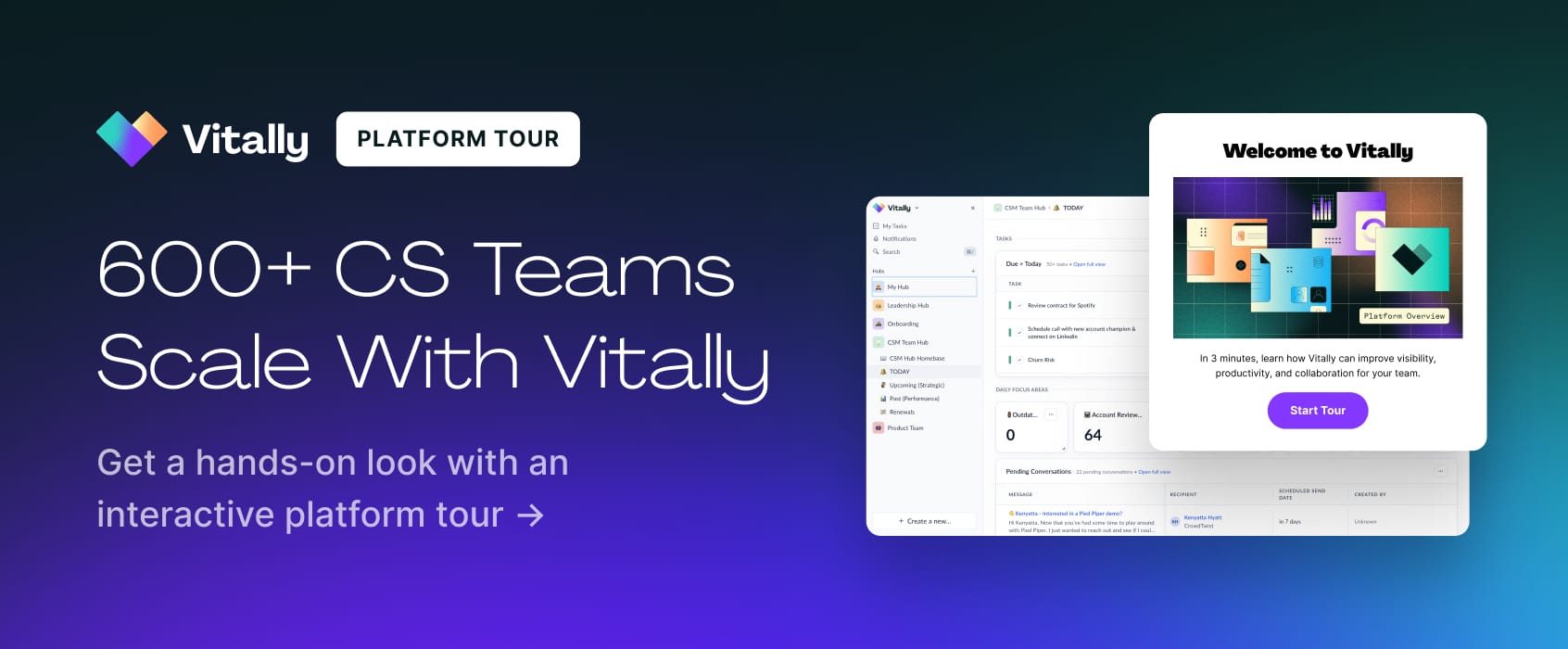
Wouldn’t it be nice if there was some perfect formula for measuring the revenue impact of your Customer Success team’s efforts, no matter what company you’re at? Unfortunately, no such formula exists. Like most things in life, choosing which KPIs to track is just not that simple.
But, it’s also not that complicated. We chatted with 10+ Customer Success leaders and practitioners from our hand-selected group of Success Network experts about the metrics they track on a regular basis to answer these two important questions:
- How are you measuring the impact of your CSMs and teammates?
- How are you measuring the impact the CS function has on your broader org?
Below are the 11 KPIs they shared, plus a bonus tracking strategy that’s not so KPI-focused. Treat this glossary-style article like a recipe book. May it inspire you to try something new and spice up your CS measurement in the months to come.
11 Customer Success KPIs You’ll Want to Keep an Eye On
In no particular order (besides alphabetical), here are the KPIs top Customer Success leaders are tracking to understand if their teams’ work moves the needle or not.
1. Closed-Won Percentage by Health Score
Closed-Won Percentage by Health Score is a great KPI to check up on either quarterly or bi-annually because it essentially validates (or invalidates) your scoring criteria. Are tons of your seemingly “healthy” customers churning? Or on the flipside, are tons of “unhealthy” customers staying on? Both are sure signs that your scoring system is off-kilter and not indicative of reality.
It’s an ongoing process, of course, but once you’ve got your Health Scores figured out, you can get proactive with Red accounts and work ahead of churn risk.
KPI provided by Tyler Diderich, Manager, Customer Success Engineering at runZero. Tyler shares another one of his go-to metrics in episode 10 of One Vital Question:
2. CSAT
This is the most classic Customer Success KPI (and for a good reason). Customer satisfaction (CSAT) is typically calculated using a survey like this:

You get good quantitative data this way, but if you add a free response follow-up question asking why someone responded how they did, you gain CSAT intel that:
- Helps you spot areas of opportunity in your process and product
- Gives you the information you need to mitigate future churn
- Provides direction on what your priorities should be to grow your business
In short, it helps you track how successfully you’re making what’s most important to your customers important to your organization.
KPI provided by Mary Migiano, Head of CS at Compt
3. Customer Engagement
“Customer engagement” is a buzz-phrase in the same league as “driving value.”
Thankfully, Emma Miller-Crimm offered us some tangible framing around what “customer engagement” means at her company, Level.
Emma’s team tracks customer engagement by looking at platform usage and then studying how different usage patterns trigger sales expansion and upsells. Lots of usage is one thing, but knowing what kind of usage leads to long-lasting customers is far more important.
Once they know which product engagements keep customers sticking around, Emma's team uses playbooks that are designed to introduce other customers to the “right” parts of the platform. This ups their chance of satisfying those customers and ultimately retaining their business.
KPI provided by Emma Miller-Crimm, Head of Digital Customer Success at Level
4. Health Scores
Customer Success is about people and the relationship between a client and their CSM, so it’s not possible to put a scoring system in place that perfectly measures the health of every relationship your organization maintains.
That said, a robust Health Score measurement framework is still valuable. It should be built on product usage, NPS, and CSM pulse, yes, but it can’t stop there. The scoring model needs to fluctuate and regularly be updated based on specific actions that CSMs take.
Do your QBRs make customers more or less loyal? Does quick follow-up speak volumes to customers, or do they not really care if you reply to their emails tomorrow instead? These are things you need to find out about your customer base because they’ll impact how your CSMs spend their time.
KPI provided by Linnea Olson, Sr. Customer Operations Manager at Apollo.io
5. Gross and Net Revenue Retention
Definition time: Gross revenue retention (GRR) measures what percentage of revenue is renewed from the original contract value. Net revenue retention (NRR) measures what percentage you shrunk or grew from that initial contract amount.
CSMs are highly revenue-responsible at Datasembly, where our Success Network expert Maranda Dziekonski leads CS. (And spoiler, it’s working.)
The best way to hold CSMs responsible for revenue outcomes is simple — tie CSM bonuses to the outcomes you want to see.
But do this wisely. The notorious finger-pointing between Sales and CS is only exacerbated by bonusing structures that reward the wrong people for closing deals.
Here’s Maranda’s strategy: “I have net retention set up as a team goal, and gross retention as an individual goal. Because I don't care who gets the upsell across the finish line, as long as it gets across the finish line.”
KPI provided by Maranda Dziekonski, Senior Vice President, Customer Success & Ops at Datasembly

6. Number of CSQLs
Customer Success Qualified Leads, or CSQLs, are potential buyers who have already engaged with your CS team for one reason or another. According to Annie, who provided this KPI, the success rate of selling to someone you already know is 60-70%, while the success rate of selling to a new prospect is 5-20%.
This solid line to revenue growth is powerful, and revenue from CSQLs is undeniably low-hanging fruit. Top CS leaders look for and track CSQL opportunities constantly.
If you want to find more CSQLs, try:
- Reaching out to former champions and stakeholders who’ve changed jobs
- Asking your current customers for referrals to prospects at other companies
- Looking for upsells and cross-sell opportunities within the same accounts
KPI and statistics provided by Annie Dean, CEO and CoFounder at RecastSuccess
7. Lifetime Value (LTV)
Lifetime Value (LTV) is the average revenue a customer generates over their entire relationship with your company. It’s a metric the whole go-to-market team should be close to, including sales, marketing, and CS.
For CS teams, upselling and cross-selling can boost LTV, but don’t underestimate the power of reducing churn, too. Lowering churn rates can lead to more significant and sustainable LTV improvements.
By integrating LTV calculations with the customer lifecycle and adopting a holistic approach to revenue growth and retention, you can unlock tremendous value and drive long-term success for your business.
KPI provided by Abraham Lederman, CX Director at Popular Power
8. Percentage of Seats Purchased vs. Potential Seats Purchased
This is a nuanced KPI that only applies to sold-by-the-seat businesses. If that’s your company, try tracking the number of seats a customer has purchased and the potential seats they could purchase.
To calculate this, determine the number of employees at a recently closed-won account that fit within your company’s ICP; this becomes the “number of seats they could purchase” denominator of the formula above. So, if a company has purchased 10 seats, but employs 50 of your ICP, they have 20% of their potential purchased.
The lower the percentage, the higher your effort should be to delight and grow the account (read: you should make these your high-touch accounts).
KPI provided by Sarah Cunningham-Scharf, Head of Customer Success at Great Question
9. Strategic vs. Reactive Time Spent by CSMs
CSMs are thought leaders and proactive partners, not hand-holders or firefighters.
Ola Ogungbemile, a Sr. CSM within our Success Network, says that measuring what percentage of the time CSMs feel like strategic partners versus reactive problem solvers is indicative of the health of your Customer Success organization as a whole.
Of course, being reactive is part of any job at times, and it has its place in a CSM’s work too. But for Ola, he tries to spend as much time as he can in the middle of this Venn diagram to delight and retain his customers:

KPI provided by Ola Ogungbemile, Sr. CSM at PartnerStack
10. Time to First Value
The faster the time to first value (TTFV), the better. But tracking this metric has to go beyond just checking a box based on solution implementation or X number of log-ins.
To measure this well and decrease TTFV, figure out for your organization what “first value” even looks like. Too often CSMs spend so much time being responsive, focusing on product adoption, and scrambling to keep everyone happy within an account that they forget to zoom out and ask things like:
- What would save my customer time, money, or resources?
- What can I do today that will help make our tool sticky within their organization?
KPI provided by Donna Weber, Customer Onboarding Expert at Donna Weber Consulting
11. Time to Wow
Our final KPI, Time to Wow (TTW), is a spin on the previous KPI and puts some parameters around what it means to “drive value.” This metric tracks how long it takes for a customer to feel a tangible business impact and literally say, “Wow!” or something equivalent.
This metric not only measures the speed at which customers realize the value of your product (or service), but it also captures the moment when they are genuinely impressed and see a significant positive effect on their business operations.
TTW emphasizes the importance of going beyond basic value delivery to create memorable, impactful experiences that strengthen customer loyalty and drive long-term success.
KPI provided by Irit Eizips, Chief Customer Officer & CEO at CSM Practice
One Last Thing: What About the OGSMT Framework?
So those are the 11 KPIs our Success Network experts suggest measuring if you’re looking for a better way to track (and improve) your CS team’s operational excellence and revenue impact.
However, robust KPI tracking isn’t for everyone. Kristen Gray Psychas, a regular Vitally content contributor and Director of Customer Success at Banzai, threw us a KPI-curveball and introduced us to the OGSMT (Objectives, Goals, Strategies, Measures, and Tactics) framework instead. Here’s what she said.
When Banzai went public, there was a company-wide shift away from isolated KPIs. Executive leadership was finding new and time-sensitive responsibilities with our IPO, and they needed a goal-setting and measurement methodology that allowed all team members to be fast, active contributors. Enter the OGSMT framework.
Once the executive team at Banzai aligns on objectives, a cross-functional team of non-executive leaders gets to work defining the goals, strategies, and measures needed to make those objectives happen.
Then, those non-executives delegate specific tactics across the entire organization, and execution begins. Everyone gets to work right away and feels their immediate impact on the business, all without top-down or prescribed KPIs that measure output or isolated results.
So, there’s some food for thought. And regardless of whether you’re hoping to better track Customer Success KPIs or give the OGSMT method a go, Vitally is a perfect fit for scaling CS orgs that want to better measure their revenue impact.
Curious about our software? Take a tour of our platform or schedule time with our team to learn more.









